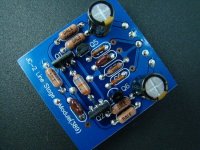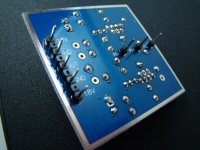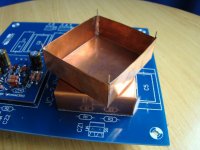Hi Andrew & lineup
Thank you for you guys' reply.
25ma is safe in this case but according to the information I got the original design of the bias current @ the output stage of JC-2 was set at 50ma with 2N4401/4403 transistors for 15v power voltage. Let's wait to see what Mr. John Curl will say about this.
To lineup
Yes I like this pcb layout very much. It is the board of the amplifier section which I am going to put it onto a small bronze box in size 2" x 1 1/2" x 1. I will post photo once the box is available.
Best Regards
Thank you for you guys' reply.
25ma is safe in this case but according to the information I got the original design of the bias current @ the output stage of JC-2 was set at 50ma with 2N4401/4403 transistors for 15v power voltage. Let's wait to see what Mr. John Curl will say about this.
To lineup
Yes I like this pcb layout very much. It is the board of the amplifier section which I am going to put it onto a small bronze box in size 2" x 1 1/2" x 1. I will post photo once the box is available.
Best Regards
If you return to the beginning of this thread, I recommended a lower operating current for the output devices and made the component changes necessary to accomplish that. I explained my rationale (including the device performance at the lower current) and gave some measurements. Mr. Curl disagreed quite strongly.
If you plan to drive long cables, you may wish to consider alternate output devices and arrange suitable heatsinking. Otherwise, I think reducing the operating current is the way to go.
Very nice looking boards!!!
If you plan to drive long cables, you may wish to consider alternate output devices and arrange suitable heatsinking. Otherwise, I think reducing the operating current is the way to go.
Very nice looking boards!!!
'Mr Curl disagreed strongly' 😀
I could just figure this.
Curl likes to run at high currents in JFET. This is no secret by now.
He advocates 2SK170V = highest current class..
And when it comes to JFETs I think he is VERY right.
I guess he is not only after high gain when using very high currents in bipolars, too.
I think more it is about HF slewrate.
It is true that 2N4401 will be faster at very high currents (>50 mA).
But any transistor is a set of parameters. A whole bunch!
Some will be degraded with higher current.
Nelson Pass says: There is a 'sweet spot' to operate any semiconductor/MOSFET.
For me this 'sweet spot' regarding small signal transistors like 2N4401 is not close to doing a burn out.
It more at the middle to modrately high power level.
My borderline is like 50-60% of a 500mW device.
Which gives like 250-300 mW.
For a higher power TO-92 variant like 2N4401, still plastic, I would set my max to maybe 450 mW,
but only if I was sure this would give me some detectable better output performance, without other drawbacks.
Which here I doubt.
Regards, Lineup
I could just figure this.
Curl likes to run at high currents in JFET. This is no secret by now.
He advocates 2SK170V = highest current class..
And when it comes to JFETs I think he is VERY right.
I guess he is not only after high gain when using very high currents in bipolars, too.
I think more it is about HF slewrate.
It is true that 2N4401 will be faster at very high currents (>50 mA).
But any transistor is a set of parameters. A whole bunch!
Some will be degraded with higher current.
Nelson Pass says: There is a 'sweet spot' to operate any semiconductor/MOSFET.
For me this 'sweet spot' regarding small signal transistors like 2N4401 is not close to doing a burn out.
It more at the middle to modrately high power level.
My borderline is like 50-60% of a 500mW device.
Which gives like 250-300 mW.
For a higher power TO-92 variant like 2N4401, still plastic, I would set my max to maybe 450 mW,
but only if I was sure this would give me some detectable better output performance, without other drawbacks.
Which here I doubt.
Regards, Lineup
You bring up many good points.
I'm still convinced that the ultimate slew rate will be determined by the load capacitance. If you aren't planning to drive long cables, I don't see what the higher device current provides other than a shorter life for the part. The data sheet also indicates performance advantages at the lower current.
If you plan to drive long cables, then the higher current makes more sense, but with a different or a heatsinked device.
I'm still convinced that the ultimate slew rate will be determined by the load capacitance. If you aren't planning to drive long cables, I don't see what the higher device current provides other than a shorter life for the part. The data sheet also indicates performance advantages at the lower current.
If you plan to drive long cables, then the higher current makes more sense, but with a different or a heatsinked device.
john curl said:V is best, Bl next, and GR will do in a pinch.
Hi Mr. Curl,
i would like to know the difference ( in the sound ) with higher current and lower current in the input stage? Thank you! Maxpou
jonusgrumby said:If you return to the beginning of this thread, I recommended a lower operating current for the output devices and made the component changes necessary to accomplish that. I explained my rationale (including the device performance at the lower current) and gave some measurements. Mr. Curl disagreed quite strongly.
If you plan to drive long cables, you may wish to consider alternate output devices and arrange suitable heatsinking. Otherwise, I think reducing the operating current is the way to go.
Very nice looking boards!!!
Hi Tom
I will do some experiments shortly to change the Emitter resistors at the output stage to 30 & 40 Ohm respectively to reduce the bias current to see if there is any sonic changes. It is hard to found heat sink suitable for TO-92 packaging nowadays. I had seen heat sink for TO-92 before but not any more.
Best Regards
The original line amp for the JC-2 was made for 600 ohm loads and used T0-5 transistors running at 50 ma. The later JC-2 circuits were made for 5K loads and used the 2N4401-3 devices, for example, but others can be used as well. These were enclosed in a thermal epoxy which was a pretty good heat sink. You MUST heat sink the output devices to get best performance. You could run at a somewhat lower current, perhaps 25ma on the outputs.
The parts that I found best were made by RCA and Kertron, both difficult parts to get today. I would recommend a plastic equivalent part pair, today, 40V min breakdown, good Ft, linear beta between 5 and 50ma, power diss. 0.5W min, 2W if you can get it. As I don't use bipolar transistors very often, anymore, I don't have a good recommendation at the moment
I changed the emitter resistors at the output stage from 20 Ohm to 40 Ohm. It seems the low frequency has better control and the sound stage is more stable when the bias current of the amp is set @ 50ma.
I like the sonic quality that the amp reproduces with 50ma bias. I am waiting for Ken to send me some heat sinks.
😎 😎
I like the sonic quality that the amp reproduces with 50ma bias. I am waiting for Ken to send me some heat sinks.
😎 😎
Ft of both D647/B667 is 140 Mhz while 2N4401/4403 is 250 Mhz. 2N4401/4403 has the best Ft among the following transistors:
MPS8099: 150 Mhz
MPSA 06: 100
2N3439: 15
2N5415: 15
2N5210: 30
ZTX751: 140
2N2907: 200
Would like to hear from others especially Mr. Curl's recommendation.
MPS8099: 150 Mhz
MPSA 06: 100
2N3439: 15
2N5415: 15
2N5210: 30
ZTX751: 140
2N2907: 200
Would like to hear from others especially Mr. Curl's recommendation.
HKC said:I changed the emitter resistors at the output stage from 20 Ohm to 40 Ohm. It seems the low frequency has better control and the sound stage is more stable when the bias current of the amp is set @ 50ma.
I like the sonic quality that the amp reproduces with 50ma bias. I am waiting for Ken to send me some heat sinks.
😎 😎
you do what you find best
if 50 mA works without any damage to your transistors, then use it 🙂
You say:
It seems the low frequency has better control and the sound stage is more stable
It seems ... are the keywords here!
... you know, as I do, that listening test are very unsure & subjective criteria.
The more secure listening test and more scientifically correct
would be ABX Blind Testing .. with the ability to switch between 25/50 mA
without actually knowing what output current you listen to
Maybe you have some friend/girlfriend to help you switch secretly?
But this you of course are aware of, already.
This is plain common audio knowledge.
Lineup regards
Hi lineup
I totally agree with you about blind testing. My comments for 25/50ma listening is only an initial test. I will hold a blind listening test as you suggested when I have time in the up coming future.
😀 😀
I totally agree with you about blind testing. My comments for 25/50ma listening is only an initial test. I will hold a blind listening test as you suggested when I have time in the up coming future.
😀 😀
- Home
- Source & Line
- Analog Line Level
- Variation on the JC-2 preamplifier



